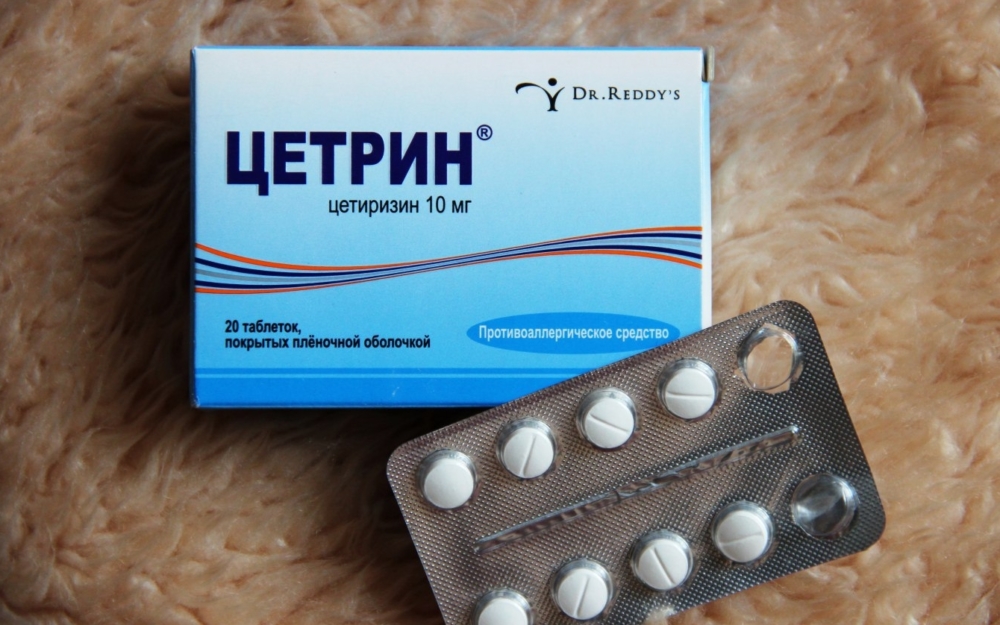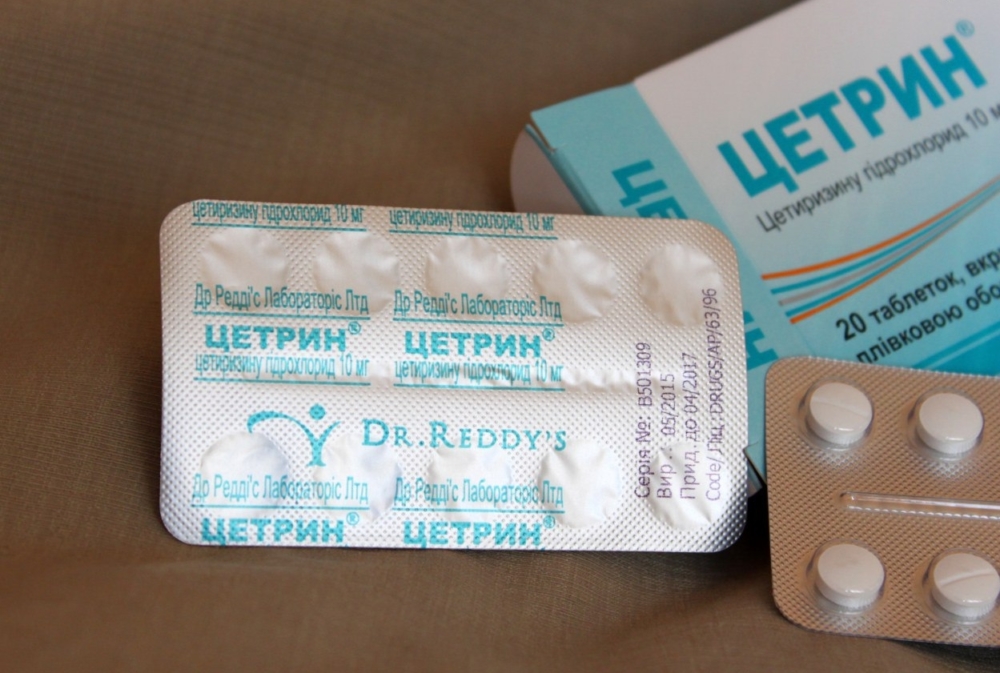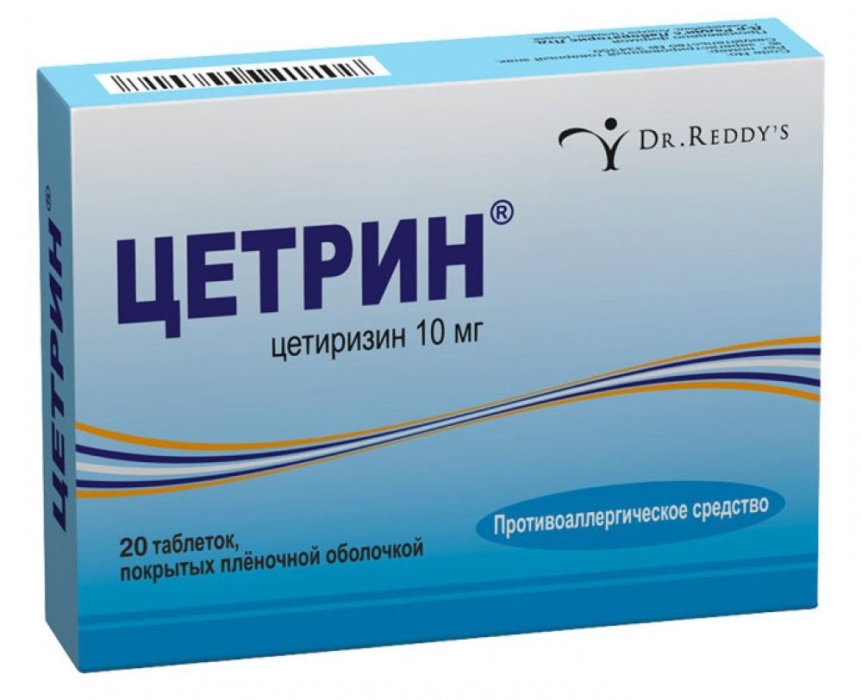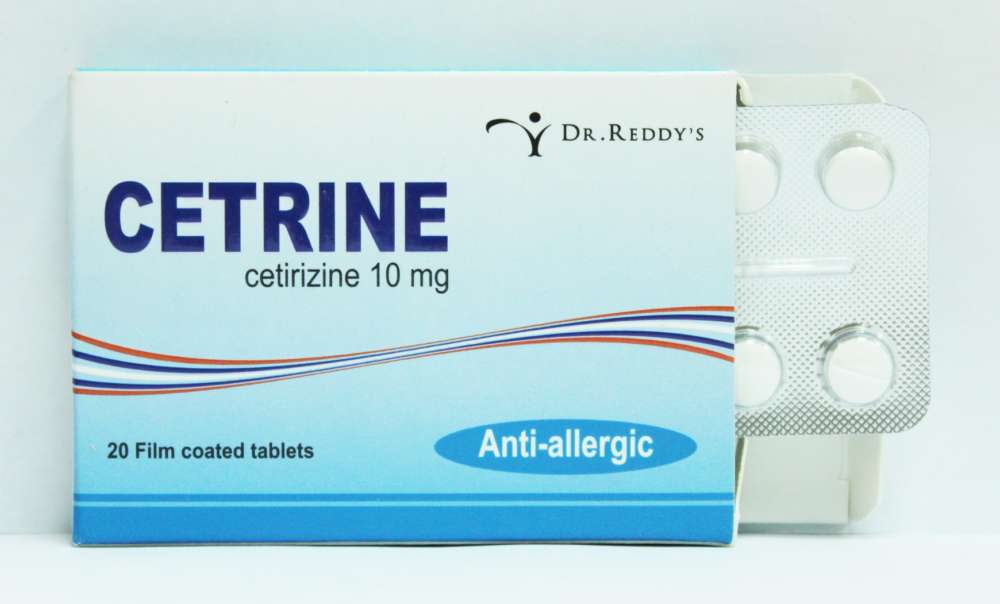Allergic reactions can concern both adult patients and children. This condition requires the supervision of a doctor and taking specialized medications, one of which is Tsetrin. This is a syrup or tablets that quickly relieve itching, help to eliminate the rash and other signs of hypersensitivity. Instructions for use of Cetrin for children are simple and understandable, therefore, as a rule, there are no difficulties in treatment.
Material Content:
The composition of the drug
Tablets contain only one active ingredient - cetirizine hydrochloride. It is this compound that provides antiallergic activity. The composition also includes a number of auxiliary ingredients, including:
- magnesium stearate;
- lactose;
- starch;
- povidone.
Each tablet is coated, the constituent components of which are:
- hypromellose;
- talc;
- sorbic acid;
- dye;
- macrogol;
- polysorbate.
Another form of release is an internal syrup with a concentration of 1 mg / ml liquid. As additional components are used:
- glycerol;
- benzoic acid;
- water;
- sodium citrate;
- disodium ederate;
- sucrose;
- flavorings.
On a note! Both syrup and tablets act in the same way.
Pharmacological properties
Cetrine tablets are prescribed for children with allergic reactions.They work according to the following scheme: cetirizine enters the bloodstream through the villi of the small intestine and is distributed throughout all body tissues. This chemical compound is a histamine antagonist. It blocks histamine receptors, which leads to inhibition of allergic reactions.
If you take Cetrin in the early stages of an allergy, you can achieve the maximum effect. In this case, inflammatory mediators do not have time to be released, the permeability of the capillary walls decreases, the migration of eosinophils and neutrophils slows down.
Against the background of the use of the drug, the following effects are observed:
- elimination of edema;
- relieving itching;
- reduction of rash.
Important! The drug begins to act quickly. The first signs of improvement in well-being become apparent after 20 minutes after taking.
What is Cetrin prescribed for children
Cetrin is a powerful antiallergic drug, which is prescribed for the following indications:
- hay fever;
- hives;
- Quincke's edema;
- conjunctivitis;
- allergic dermatoses.
Another indication for taking the medication is bronchial asthma. In this case, the tablets will play the role of an auxiliary element of therapy.
At what age can a child be given
The medication in the form of tablets has an age limit. It should not be given to children under the age of 6 years. Babies from 2 to 6 years old can be given medicine in liquid form. If the child is older than 6 years, then for treatment you can use both tablets and syrup in the dosages indicated in the annotation for the medicine, which can be found in the package.
Instructions for use and dosage
The dosage of Cetrin for children is determined by the form of release and the age of the child.
- Children over 6 years old should take 1 tablet (10 mg of the active substance) once a day. This amount can be divided into two methods.
- Children under 6 years of age can be given 1-1.5 ml of syrup per day. This dose can be doubled in severe allergies.
- Children over 6 years old take 5 ml of syrup. It is also allowed to increase the dose if necessary.
The medication is taken orally, washed down with water. Eating does not affect the digestibility of the product.
Drug interaction
Tablets and syrup are well tolerated and rarely interact with other agents. It is only important to remember that while taking with any sedative drugs, the concentration of attention decreases.
In addition, the parallel administration of an allergy drug with Theophylline leads to the accumulation of the active component of this drug in tissues and blood plasma. This can lead to intoxication. Doctors urge not to worry, since a similar picture is most often observed with a significant excess of the dosages of medicines.
Contraindications, side effects and overdose
You can give allergy pills to children only by making sure that the baby has no contraindication.
Limitations for admission are:
- age less than 2 years (for liquid medicine);
- age less than 6 years (for dragees);
- hypersensitivity;
- renal failure.
Side effects from the use of the drug are not excluded. The most common among them are dry mouth and mild drowsiness. If these symptoms are inconvenient, it is allowed to reduce the dose of the medicine.
Other side effects include:
- migraine;
- dizziness;
- heaviness in the stomach and intestines;
- increased skin allergic reactions.
With a significant excess of the volume recommended by the pediatrician, an overdose of the drug is possible. The active substance negatively affects the digestive tract and the nervous system. This is manifested by the following symptoms:
- dry mucous membranes;
- headache;
- anxiety and panic attacks;
- fast fatiguability;
- general malaise;
- tachycardia;
- drowsiness;
- itchy skin;
- diarrhea;
- urinary retention.
There is no specific antidote to Cetrin, so a patient with signs of an overdose should be sent immediately to a medical institution, where the doctor will monitor his condition.Gastric lavage may be required. Some patients are given laxatives to quickly empty their bowels.
Analogs of an antiallergic drug
The main reasons why children are given allergy pills are itching, skin rashes, rhinitis, conjunctivitis. When these symptoms appear, it is important to respond as quickly as possible. In the early stages of allergies, almost all medications are effective, so the doctor can prescribe not only Cetrin, but also one of its analogues.
- Cetirizine. This is a completely identical in composition inexpensive drug produced in Russia and India. In its composition - the chemical of the same name, which quickly blocks histamine receptors. Suitable for children from 6 years. From year on, babies can be given a different form - Cetirizine Hexal drops.
- Zirtek. This is another cetirizine-based drug. Swiss pharmaceutical companies produce tablets that can be given to children from 6 years old. In factories in Italy and Belgium, drops with a reduced dosage of the active substance are produced. They are allowed from 1.5 years.
- Zodak. The Czech line of allergy medications, presented in drops, syrup and tablets. The active substance is cetirizine. Drops give babies from 1 year old, syrup - from 2 years old, tablets - from 6 years old.
In some cases, drugs with a different chemical composition are appropriate. They are also designed to block histamine receptors and prevent eosinophil migration. As a result, the rapidly developing allergic reaction is inhibited, and the child begins to feel much better.
The closest similar substance to cetirizine according to the principle of action is levocetirizine. This component is part of such drugs:
- Alerzin (tablets and drops);
- Aileron (dragee);
- Tsetrilev (dragee);
- L-Cet (tablets).
Medicines in the form of dragees, by analogy with Cetrin, are given to children after reaching the age of 6 years, while the drug in the form of drops is allowed already from 6 months.
There are a number of other medications that help fight allergies. So, on the positive side, Loratadin with the same substance in the composition has proved itself. The drug is available in the form of tablets and syrup. It is designed to block histamine receptors and inhibit the spread of inflammation. Its characteristic difference from other analogues is the minimal number of side effects. The tool rarely provokes drowsiness, for which it is appreciated by doctors. Syrup is given to children from two children, and tablets - from 12 years.
Allergies can cause a lot of inconvenience to a child, so the task of parents is to quickly find a safe tool that will have a positive effect. It is difficult to cope with this task without a pediatrician. Only a doctor will be able to assess the condition of the child and prescribe an adequate treatment regimen, as well as give additional recommendations for taking anti-allergic drugs.


















